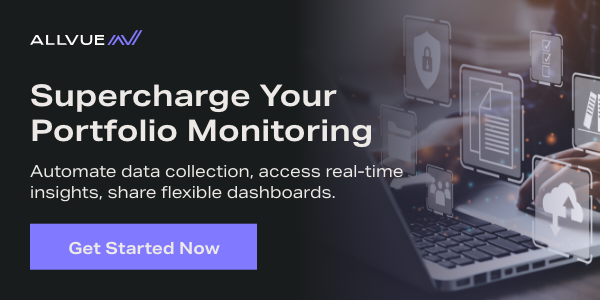
By: Allan Parks
Product Manager, Portfolio Monitoring
May 31, 2024
Private equity (PE) seeks out unlisted companies with strong growth potential and provides them with funding to fuel their expansion — usually in exchange for an ownership stake. The hope is that through this capital injection plus strategic and operational support, the companies will improve their operations, grow in value, and ultimately generate a positive return on investment (ROI).
However, like any other investment, there are no guarantees of positive returns in private equity. In fact, private equity comes with a variety of risks. Because of this, PE firms need to closely monitor the companies they invest in (i.e., their portfolio) to confirm they are on track to deliver the value envisioned and act, if necessary, to manage risk and maximize return potential.
This guide explores portfolio monitoring in private equity. We’ll cover what it is, how it works, the benefits it offers, the main challenges, and how to overcome them.
Defining portfolio monitoring
Portfolio monitoring in private equity is the active process of tracking, analyzing and interpreting the performance of a fund’s holdings — which are primarily private companies. The main goal is to ensure that the portfolio remains aligned with the fund’s long-term objective, which is to create value for its investors.
This monitoring goes beyond just the financial health of the portfolio companies. It also looks at other areas that can affect performance — such as corporate governance, legal and regulatory compliance, and finally risk controls and their impact on performance and value creation.
Through portfolio monitoring, PE funds can assess the progress of each of their investments, identify potential issues early on, and make strategic decisions that safeguard and ultimately enhance the interests of their investors.
The importance of performance monitoring
Portfolio monitoring in private equity serves several important functions. Let’s explore the most important of these functions.
Tracking performance
Portfolio monitoring allows PE funds to monitor how their investments are performing, both individually and at the fund level. It helps them evaluate whether their portfolio companies are on track to meet projected or desired goals and where adjustments are necessary to continue creating value for investors.
Adapting to market conditions
The business landscape can shift rapidly, affecting the performance of private equity investments. Regular monitoring enables PE firms to adapt their strategies to changing market conditions.
Whether it’s fluctuating interest rates, shifts in consumer behavior, or changing regulations, portfolio monitoring helps PE firms stay alert. This allows them to make timely adjustments to their portfolio to protect their investors’ money.
Mitigating risk
Monitoring helps identify potential threats to value creation — both in the wider market and within individual companies in the portfolio. Once a risk is identified, the fund can take steps to reduce its exposure.
Identifying opportunities
The business landscape in which PE funds operate regularly presents new opportunities. By monitoring its portfolio and analyzing the performance of the underlying investments, a PE fund can identify emerging trends or sectors that are showing high growth potential. It can then capitalize on these opportunities by directing resources towards them.
Confirming compliance
Regular monitoring helps confirm that a PE fund’s portfolio companies are compliant with current laws and regulations. This helps avoid any financial and legal penalties (such as fines and lawsuits) that could arise from non-compliance.
Fostering good investor relations
Investors in private equity funds, known as limited partners (LPs) expect clear and timely communication about the fund performance.
Portfolio monitoring empowers the fund’s managers, also called general partners (GPs), to meet this expectation through detailed reports that demonstrate progress toward value creation.
Furthermore, portfolio monitoring allows GPs to proactively address any concerns LPs might have about their investments. This transparency fosters trust and strengthens relationships between the two parties.
Performance benchmarking
Monitoring helps PE funds benchmark their portfolio’s performance against industry standards and competitor funds. This allows them to clearly demonstrate their track record, which can attract capital in future funds.

Key components of portfolio monitoring
Portfolio monitoring is made of several components, let’s break them down.
Financial performance monitoring
This is one of the most critical components of portfolio monitoring. It involves assessing the financial health and performance of portfolio companies. That means tracking metrics like:
Financial performance monitoring helps PE funds determine if their portfolio companies are meeting their financial goals and delivering expected returns. Early detection of underperformance enables PE firms to react accordingly.
Operational performance monitoring
Operational performance monitoring is the other important component of portfolio monitoring. This evaluates how well the portfolio companies are running their businesses. That means tracking and assessing factors like:
- Production efficiency
- Market position or market share
- Employee productivity
- Customer satisfaction
- Turnover rates
- Customer acquisitions costs
- Sales growth
These operational performance metrics reveal how well the portfolio company is turning its strategies into results. They help assess if the value creation plan is on track, identify areas where operational improvements can unlock additional value, and uncover potential risks from inefficient operations.
Governance and compliance
This component of portfolio monitoring assesses the portfolio governance practices and compliance with relevant laws and regulations. More specifically, it entails:
- Assessing a company’s corporate governance structures, procedures, and policies to make sure they are strong and effective and that they are based on established standards or best practices.
- Tracking adherence to industry-specific regulations and legal requirements, including securities laws, anti-corruption laws, labor laws, financial reporting standards, and even environmental regulations.
Strong governance protects the investment from mismanagement and reputational risk. Meanwhile, effective compliance ensures the company operates within the law, avoiding potential fines, lawsuits, and other issues such as loss of operating licenses.
Risk identification
This component involves identifying the potential risks that could impact the portfolio companies, their performance, and therefore their value. These include:
- Market risks (e.g., economic downturns, interest rate fluctuations)
- Operational risks (e.g., supply chain disruptions, production issues)
- Credit risks (e.g., borrower default)
- Legal and regulatory risks (e.g., changes in laws and regulations)
Early identification of risks allows for proactive measures to mitigate them. This could involve reallocating investments around, diversifying portfolio risk, or working with portfolio companies to address internal weaknesses.
How Portfolio Monitoring Works
The private equity portfolio monitoring process involves three key steps, outlined below.
1. Data collection
This is the first step, and it acts as the foundation for portfolio monitoring. It involves gathering high-quality and timely data from all of the investments in your portfolio. The data can come from various sources, including the portfolio companies themselves, press releases, industry reports, financial news outlets, and third-party financial data providers.
2. Reporting
Once data is collected, the next step is to compile it into reports. The reports typically fall into the four categories of portfolio monitoring we mentioned earlier; finances, operations, governance and compliance, and risk.
Digital portfolio monitoring tools can streamline this process. These tools can gather data, perform necessary calculations, and format the information into clear and easy-to-understand reports. They can even automatically distribute these reports to your investors, ensuring timely and consistent communication.
3. Analysis and action
The final part is to analyze the reports, generate valuable insights, and then use these insights to make informed decisions. For example, you might decide to sell an underperforming investment, put more money into a high-performing one, or adjust your overall investment strategy based on market conditions.
Challenges in portfolio monitoring
While portfolio monitoring is an important part of private equity, it’s not without its hurdles. Here are some of the main challenges that can hinder the process:
Inconsistent and incomplete data
Data formats and definitions can vary across portfolio companies. This can complicate information analysis and lead to misinterpretations.
Additionally, missing data points can result in an incomplete picture of portfolio performance, making it difficult to draw reliable conclusions including the actual health of the portfolio.
There are ways to overcome these challenges. One approach is establishing standardized reporting templates for all the companies in the portfolio. This ensures everyone is using the same format and definitions, which makes it much easier to analyze the data.
Another solution is to automate data feeds from the portfolio companies. This eliminates the need for manual data entry, which is a major source of inconsistencies and missing information. Automated systems can also be programmed to flag missing data and request updates, helping to ensure a more complete data set.
Integrating diverse information systems
Modern businesses rely on a complex mix of software and databases. When monitoring a portfolio, integrating data from these disparate systems can be a challenge. Different systems may not be designed to communicate with each other. Firms might be forced to manually extract and consolidate data, which, unfortunately, can be both time-consuming and error-prone.
There’s a solution to this challenge however — something called Application Programming Interface (API). APIs act like bridges, allowing different software solutions to communicate with one another. Allvue’s private equity solutions come equipped with built-in API capabilities, seamlessly integrating with other systems.
Resource and money constraints
Effective portfolio monitoring requires time, skill, and money. Organizations may not have the staff or resources needed to adequately monitor their portfolios. Here are two solutions to consider.
- Partnering with portfolio monitoring experts: Working with third-party service providers who specialize in portfolio monitoring can be a cost-effective way to ensure comprehensive oversight without straining internal resources.
- Leveraging portfolio monitoring tools: Software solutions like Allvue’s portfolio monitoring software can automate many of the monitoring tasks. This reduces the need for a large dedicated team, saving you money without sacrificing effectiveness in monitoring.
Wrapping up: Allvue’s role in portfolio monitoring
Portfolio monitoring involves actively tracking a fund’s holdings and analyzing their performance across various aspects like finances, operations, and governance. It’s a cornerstone of success in modern private equity investing, helping portfolio managers keep an eye on their holdings and confirm alignment with their investment thesis and goals.
Traditionally, portfolio monitoring was done manually using tools like spreadsheets which made the process time-consuming, expensive, and error-prone. Today, technology has transformed this landscape. Specifically, technologies like automation and artificial intelligence have made data collection, analysis, and decision-making faster, more efficient, and more insightful.
At Allvue, we’re at the forefront of this exciting shift, developing advanced tools to help you monitor your investments more effectively.
Our industry-leading portfolio monitoring software streamlines the entire process from data collection to analysis to reporting to sharing portfolio company data. With features like real-time data access, drill-down analysis, and customizable reports, Allvue empowers you to get a holistic understanding of your portfolio, identify valuable opportunities, and make data-driven decisions to maximize returns for your investors.
To learn more, contact us today. Alternatively, request a free demo to see firsthand how Allvue can help you.
Sources
IBM. What is an API (application programming interface)? https://www.ibm.com/topics/api
CPS. AI’s Role in Strategic Portfolio Management. https://www.cps.co.uk/insights/blog/ai-s-role-in-strategic-portfolio-management/
IFSA. Private Equity: 5 Key Private Equity Risks and How to Manage Them. https://ifsaprivateequity.com/2023/01/12/5-key-private-equity-risks-and-how-to-manage-them/
More About The Author

Allan Parks
Product Manager, Portfolio Monitoring
Allan Parks, Product Manager of Fund Performance and Portfolio Monitoring Solution joined Allvue in 2021. Previously, he was a Product Manager of Portfolio Construction Services at Capital Group, and prior to that, a Portfolio Advisor at Merrill Lynch’s Private Banking and Investment Group where he led Private Capital (Alternative Assets) portfolio allocation for a $5Bn AUM team serving foundations, family offices and UHNW. He is a graduate of University of San Diego, he holds an MBA from Thunderbird School of Global Management (ASU), and he is a CFA Charterholder.





